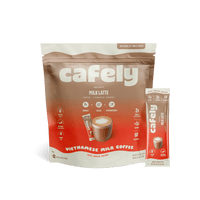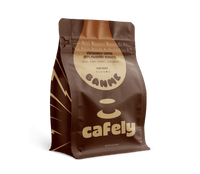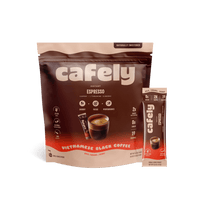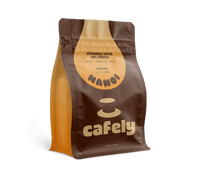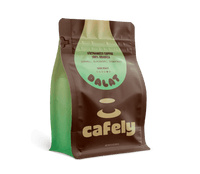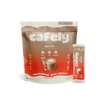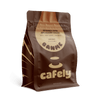Sumatran coffee is bold, earthy, and dark. Its unique taste comes from the volcanic soils of Sumatra and a unique wet-hulling processing method performed on the island. This popular arabica coffee comes in many varieties and is famed for its low acidity, deep chocolatey notes, and hints of tobacco.
Read on to learn about Sumatra coffee, its origins, what makes it unique, and the best brewing methods that allow its flavor profile to shine.
What is Sumatra Coffee?
Sumatra coffee is a type of coffee grown on the island of Sumatra in Indonesia. This arabica coffee is famed for its full body, low acidity, and unique flavor profile that comes from the tropical climate and volcanic soils of the island.
Sumatran coffee also gets its flavor profile from a unique wet-hulling (Giling Basah) process the beans of the region go through. Giling Basah is a process that begins with the fermentation of coffee cherries. The flesh is then removed, and the parchment layer is left on until the beans have a 30% to 35% moisture content. The parchment layer is then removed, and the beans are dried fully.
This unique processing method significantly impacts the flavor profile of the coffee. It results in beans with earthy, bold, full-bodied flavor and low acidity.
What Does Sumatra Coffee Taste Like?
Sumatran coffee is known for its complex and unique flavor profile. These arabica beans have a full body, low acidity, and earthy, spicy notes. The exact flavor of Sumatra coffee can vary depending on the region it's grown.
Most Sumatran coffee varieties display these flavor notes:
- Earthy & Herbal — Notes of cedar, pine, moss, thyme, and rosemary.
- Chocolate — Notes of dark chocolate, cocoa, and dark caramel.
- Spices — Notes of cinnamon, cloves, and black pepper.
- Woody & Smoky — Notes of walnut, oak smoke, and tobacco.
- Fruit — Deep grape or wine-like flavors, notes of dates, raisins, and black cherry.
Sumatra Coffee Varieties
There isn't one strict type of Sumatra coffee. Several varieties from different regions on the island exist, and although they're all similar, each has unique traits.
Here are some of the most popular Sumatran coffee varieties and their characteristics:
1. Mandheling Coffee (Northern Sumatra)

Mandheling coffee is grown in the fertile volcanic soils of Northern Sumatra. It's famed for its rich, complex flavors and smooth, full-bodied texture.
Mandheling coffee has deep, dark, earthy notes with hints of dark chocolate or cocoa, tobacco, and wood. It has a low acidity and a velvety, smooth texture when brewed well. It's one of the most distinguished Sumatran coffees, favored by coffee connoisseurs who appreciate strong, bold, balanced brews.
2. Gayo Coffee (Aceh Highlands)

Gayo coffee is grown in the high-altitude regions of Aceh. It's famed for its natural sweetness and pungent aroma.
Gayo coffee has a caramel or honey-like sweetness and a smooth, mellow texture. It's much more subtle than Mandheling coffee in terms of flavor — suiting coffee lovers who want a soft, smooth, “easy-drinking” brew. With that said, Gayo coffee still offers a complex taste that suits distinguished palates.
3. Lintong Coffee (Lintong Nihuta Region)

Lintong coffee is grown in the Lintong Nihuta region close to Lake Toba.
Lintong coffee has a thick, syrupy body and natural sweetness. However, it's much more bold than other Sumatran varieties. It has an intense earthy flavor with notes of herbs and spices. When brewed using immersion or cold-brewing methods, it can exhibit floral, fruity, and citrusy notes.
These Sumatran beans have a multidimensional flavor profile that can be appreciated by the coffee connoisseur who desires a strong, charismatic brew.
4. Lampung Coffee (Southern Sumatra)

Lampung coffee is grown in the southern parts of Sumatra. It's renowned for its bold, dark, and robust characteristics.
Lampung coffee is primarily a variety of robusta. It's often described as having a deep, smoky aroma and rich, earthy flavor profile. This variety is much more bitter than other Sumatran coffees and contains around twice the amount of caffeine.
Unlike the smoother arabica varieties from other parts of the island, Lampung robusta offers a much more intense experience and a higher acidity. It's often favored for strong, milk-based brews such as coffee lattes and flat whites. It also creates a strong, bold, dark espresso with a unique bitter edge.
5. Sidikalang Coffee (Lake Toba Highlands)

Sidikalang coffee is cultivated in the high-altitude region of Northern Sumatra, close to Lake Toba. The region's rich, volcanic soils give Sidikalang a unique flavor similar to Mandheling coffee, although slightly milder.
Known for its well-balanced flavor, this coffee blends natural sweetness and smoothness with deep, bold, nutty flavors. It's often described as chocolatey, nutty, and slightly spicy — making it the perfect choice for espresso and milk-based brews.
Why is Sumatra Coffee Popular?
Indonesian coffee, such as Java and Sumatra, are popular for a number of reasons.
Here's what makes Sumatra coffee so sought after:
1. Limited Production
Although Sumatra is one of the largest coffee-producing islands in Indonesia, the production of each of its coffee varieties is relatively limited.
Sumatra is made up of smaller coffee cooperatives, each offering unique Sumatran coffee varieties. This limited output enhances the appeal of the coffee giving certain varieties a sense of exclusivity — raising the cost of the coffee.
2. Unique Processing Methods
Coffee beans in Sumatra are (usually) processed using a wet-hulling technique known as "Giling Basah." This process retains the earthy, woody, floral notes of the coffee, giving the beans characteristics that are completely unique.
The wet-hulling process speeds up the overall processing time — from raw cherries to raw, dried beans. However, it's much more labor-intensive, leading to a higher cost per kilogram compared to dry-processed coffee.
3. One-of-a-Kind Flavor Profile
Sumatran coffee offers a unique flavor profile compared to other coffee from across the globe. Coffee from Sumatra is known for its rich, bold, earthy flavor, but several varieties from around the island can have vastly different flavor profiles.
From the volcanic soils of the highlands to the wet, free-draining, sandy soils of the south, Sumatra's unique environment produces coffee with a diverse range of flavors. This allows coffee brands to charge higher premiums for their coffee — consumers won't find similar beans anywhere else.
How to Brew Sumatra Coffee: Three Ways
You can brew Sumatra coffee in a number of different ways. You can make great-tasting Sumatra coffee with almost any brewing method. However, a select few provide a vehicle for the unique flavor profile of this coffee to shine.
Here are four great ways to prepare Sumatra coffee:
1. Making Cold Brew Coffee With Sumatra Coffee

Cold brewing method is an excellent way to extract and enjoy the flavors of high-quality Sumatra coffee. This immersion brewing method relies on the submersion of coffee grounds in cold water for an extended period — usually 18 to 24 hours. The resulting brew has a much lower acidity and brighter flavor profile than hot-brewed coffee.
Here's how to make cold brew with Sumatra coffee:
- Measure and Grind the Coffee: Weigh out around 13 grams of coffee for each one-cup serving you wish to brew. Grind the coffee coarse — around the same consistency as kosher salt.
- Add the Coffee Grounds: Add the coffee grounds to the bottom of your French press.
- Add the Water: Add the required amount of cold, fresh, filtered water to your French press and stir to thoroughly combine the grounds. Place the lid on top of your press.
- Brew the Coffee: Place your French press in the refrigerator and leave the coffee to brew for 18 to 24 hours.
- Strain the Brew: After 18 to 24 hours, remove the press from the fridge and slowly push down the plunger to separate the grounds from the cold brew.
- Serve and Enjoy: Add some ice to a glass and gently pour in your cold brew. If you've made more than one serving, pour your brew into a sealed jug or jar and refrigerate. Cold brew keeps for around one week before it begins to lose flavor.
2. Brewing Sumatra Coffee With an Espresso Machine

Aside from the best coffee for espresso, the bold, woody flavors of Sumatran coffee work wonderfully in espresso. This brewing method requires an espresso machine or a stovetop brewer such as the moka pot. Espresso coffee is produced by forcing pressurized hot water through finely ground coffee. The resulting brew is dark, bold, and highly caffeinated.
Here's how to make espresso with Sumatra coffee:
- Measure and Grind the Coffee: Grind nine grams of coffee for a single shot or 18 grams for a double shot to a fine consistency — similar to powdered sugar.
- Fill the Portafilter: Fill your portafilter with ground coffee and apply even, firm pressure with your tamper.
- Brew the Espresso: Lock in the portafilter to the group head of your espresso machine and place a demitasse cup on the drip tray. Begin extracting your shot and time it for 25 to 30 seconds. Once brewed, remove the portafilter and discard the spent grounds.
- Evaluate Your Shot: Evaluate the quality of your shot. It should be dark, rich, and bold with a creamy, caramel-colored crema. If your espresso tastes overly sour or bitter, assess the quality of your beans and adjust the grind size or the pressure you apply during tamping.
- Enjoy: Once you're happy with your espresso shot, enjoy it slowly to savor the delicate flavors of Sumatran coffee.
3. Brewing Sumatra Coffee With a Pour-Over

Pour-over brewing involves slowly pouring hot water over coarse to medium-ground coffee. Pour-over setups such as the Hario V60, Chemex brewer, and Kalita Wave produce perfectly extracted brews that highlight the delicate notes of Sumatran coffee. Pour-over coffee tastes great black or diluted with milk.
Here's how to make pour-over coffee with Sumatra beans:
- Boil a Kettle of Water: First, boil a kettle of fresh, filtered water.
- Measure and Grind the Coffee: Measure out around 30 grams of coffee for a 1–2 serving pour-over and grind the beans to a medium-coarse consistency similar in texture to table salt. Note — the exact amount of coffee and grind size can vary depending on the pour-over setup you own.
- Prepare the Filter: Place a paper filter inside your pour-over and place a cup (or collection chamber, depending on the brewer) below. Pour a small amount of hot water over the filter and then discard the water from the container below. This helps remove any impurities in the filter and preheat your equipment.
- Bloom the Coffee: Add your ground coffee to the filter and pour over a small amount of water. Wait for around 45 seconds for the grounds to “bloom.” This blooming stage releases the gasses from the grounds, resulting in a more even extraction.
- Extract the Coffee: Gently pour over the rest of your hot water, moving in a circular motion. Wait for the water to pass through the grounds and filter until the brew is collected in the cup or chamber below.
- Serve and Enjoy: Once the final drips have passed through the filter, remove the pour-over brewer and enjoy your perfectly extracted Sumatran coffee.
4. Making Sumatra Coffee With a French Press

The French press is one of the simplest immersion brewers to use.
This brewing method involves submerging freshly ground coffee in hot water for four or five minutes before straining with the plunger.
The French press produces thick, rich, and bold coffee — perfect for highlighting the nutty, woody, earthy flavors of Sumatra coffee.
Here's how to make Sumatran coffee with a French press:
- Boil a Kettle of Water: First, boil a kettle of fresh, filtered water.
- Measure and Grind the Coffee: Weigh out around 17 grams of coffee (per serving) and grind the beans to a coarse consistency — similar to kosher salt.
- Add the Coffee and Water: Add the coffee grounds to the bottom of your French press. Slowly pour in hot water, ensuring that the grounds are completely saturated.
- Brew the Coffee: Place the lid on the French press to retain heat, but don't press the plunger down just yet. Wait for four to five minutes to allow time for the coffee to extract.
- Strain the Brew: Once four to five minutes have passed, slowly press the plunger down to separate the grounds from the brew.
- Pour and Enjoy: Pour your coffee into your favorite coffee mug. Sweeten with sugar (if desired) and enjoy black or with a splash of milk.
How Does Sumatra Coffee Compare to Beans From Around the World?
Although there are only two main types of coffee grown across the globe — arabica and robusta — their flavor profiles differ dramatically depending on where the coffee is cultivated. Coffee beans from different regions, countries, and altitudes can all taste different — even if they're all from the same species.
Here's how coffee from across the globe compares to Sumatra coffee:
1. Java Coffee
Java coffee comes from the island of Java in Indonesia. A neighbor in the island nation, Java coffee shares several similarities with Sumatran coffee. However, it does have a few distinct characteristics that set it apart and make it even more sought-after.
Java coffee is renowned for its smooth, well-balanced flavor, full body, and moderate acidity. These beans often display notes of nuts, spice, and chocolate. Earthy, herby undertones can also be detected but they're not as noticeable as Sumatran coffee.
2. Vietnamese Coffee
Vietnam is the second largest coffee producer in the world, with a global share of 16% — around 27.5 million 60 kg bags per year. It's famed for its robusta — a coffee bean with bold, dark, woody flavors and around twice the amount of caffeine as arabica.
Although Sumatran coffee shares similar qualities, Vietnamese robusta coffee is much more earthy and bitter. These beans are often prepared using a traditional brewer known as a phin filter. The brew is generally served cold over ice and combined with sweetened condensed milk to balance the strong flavors of the beans.
3. Colombian Coffee
Colombia is the second largest producer of arabica coffee after Brazil. Colombia produces around 12.76 million 60 kg bags of coffee annually.
Colombian arabica coffee is renowned for its smooth, mild, balanced flavor. They tend to have a mild acidity and notes of fruit, nuts, and caramel. Like Brazilian coffee, Colombian beans are versatile — making them a great “all-rounder” for everyday brewing.
Sumatran coffee is much more earthy, woody, and nutty compared to Colombian coffee. If you prefer a coffee that's naturally sweet, opt for Colombian. If you prefer strong, bold flavors, opt for Sumatran.
4. Ethiopian Coffee
Ethiopia is the birthplace of coffee. Species in the Coffea family are native to this African country. Although it only produces a small percentage of the world's coffee now (around 5%), Ethiopian beans are regarded as some of the best in the world.
Ethiopia almost exclusively produces arabica coffee. These beans are famed for their fruity, tropical flavors and high acidity.
Sumatran arabica is the polar opposite of Ethiopian coffee. Its nutty, woody, chocolatey flavors are completely different from Ethiopian coffee's bright, citrusy, wine-line flavors.
FAQs: What is Sumatra Coffee?
Want to learn more about Sumatra coffee and other world coffees?
Have a look through the answers to the frequently asked questions below:
1. Why is Sumatra Coffee Expensive?
Sumatra coffee tends to be expensive due to its relatively low supply compared to global demand. Its unique processing method (wet-hulling) and small-scale production also increase value.
2. How Much Caffeine in Sumatra Coffee?
Sumatra coffee contains a similar caffeine content to other arabica varieties from across the globe. A typical eight-ounce cup of Sumatra coffee made with a French press, drip coffee maker, or pour-over contains somewhere between 70 and 120 mg depending on the coffee-to-water ratio used.
3. What’s the Best Way to Brew Sumatra Coffee?
You can brew Sumatra coffee the same way as you would with any other arabica variety. However, brewing methods that highlight its rich, earthy flavors, such as French press, pour-over, and espresso, work especially well. Cold brewing is also a good method if you want to reveal the more delicate, floral undertones of Sumatra coffee.
4. Is Sumatra Coffee the Same as Java Coffee?

No. Although Sumatra and Java coffee are both from Indonesia, they are produced on separate islands and have slightly different flavor profiles. Java coffee is renowned for its smooth, balanced, floral profile, while Sumatra coffee is bolder, earthier, and nuttier.
5. What’s the Difference Between Arabica and Robusta Coffee?
Arabica and robusta are two types of coffee beans. Arabica beans are naturally sweet, smooth, and bold, while robusta beans are much darker, richer, and more bitter. Robusta coffee has around twice the caffeine of arabica coffee, and arabica has around twice the amount of sugar as robusta.
6. Can You Make Iced Coffee With Sumatra Beans?
Yes. Sumatra coffee makes delicious iced coffee. To make iced coffee with Sumatra beans, simply brew a concentrated shot using freshly ground beans and your favorite brewing method. Cool the shot and pour it over ice before diluting it with milk.
7. What’s the Difference Between Vietnamese and Indonesian Coffee?
Vietnamese coffee is typically made with robusta beans. The brew is prepared using a phin drip filter and is typically served over ice with sweetened condensed milk. Indonesian coffee is typically made with arabica and is prepared in a similar way to Arabic brews such as Turkish coffee and Greek coffee.
8. How Much Coffee is Produced in Sumatra?
Sumatra is one of the largest coffee-producing regions in Indonesia, contributing to a large portion of the country's arabica production. The Indonesian island produces somewhere between 300,000 and 600,000 metric tons of coffee per year.
9. What’s the Strongest Type of Coffee?
The strongest type of coffee is Vietnamese Peaberry robusta. Beans such as Cafely BanMe, produce twice the amount of caffeine of a typical arabica coffee.
10. What is Liberian Coffee?
Liberian coffee is a unique bean from the Coffea liberica species. This species is much less common than arabica and robusta, making up less than 1% of the world's coffee production. Liberian coffee beans are large, round, and produce distinct fruity flavors with a high acidity.

